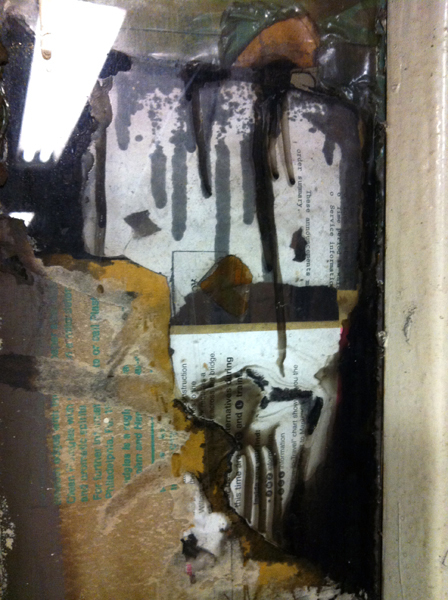Blotting Out Haman’s Name While Listening to the Reading of the Megillah (PHOTO BLOG)
 by Todd Weinstein
by Todd Weinstein
On the subject of Purim, here’s some background information from wikipedia.
The first religious ceremony ordained for the celebration of Purim is the reading of the Book of Esther (the “Megillah”) in the synagogue, a regulation ascribed in the Talmud (Megillah 2a) to the Sages of the Great Assembly, of which Mordecai is reported to have been a member. Originally this enactment was for the 14th of Adar only; later, however, Rabbi Joshua ben Levi (3rd century CE) prescribed that the Megillah should also be read on the eve of Purim. Further, he obliged women to attend the reading of the Megillah, in as much as it was a woman, Queen Esther, through whom the miraculous deliverance of the Jews was accomplished.
In the Mishnah, the recitation of a benediction on the reading of the Megillah is not yet a universally recognized obligation. However, the Talmud, a later work, prescribed three benedictions before the reading and one benediction after the reading. The Talmud added other provisions. For example, the reader is to pronounce the names of the ten sons of Haman (Esther 9:7-10) in one breath, to indicate their simultaneous death. The congregation was to recite aloud with the reader the verses 2:5, 8:15-16, and 10:3, which relate the origin of Mordecai and his triumph.
The Megillah is read with a cantillation (a traditional chant) differing from that used in the customary reading of the Torah. Besides the traditional cantillation, there are several verses or short phrases in the Megillah that are chanted in a different chant, the chant that is traditional for the reading of the book of Lamentations. These verses are particularly sad, or they refer to Jews being in exile. When the Megillah reader jumps to the melody of the book of Lamentations for these phrases, it heightens the feeling of sadness in the listener.
In some places, the Megillah is not chanted, but is read like a letter, because of the name iggeret (“epistle”), which is applied (Esther 9:26,29) to the Book of Esther. It has been also customary since the time of the early Medieval era of the Geonim to unroll the whole Megillah before reading it, in order to give it the appearance of an epistle. According to halakha (Jewish law), the Megillah may be read in any language intelligible to the audience.
Blotting out Haman’s name:
When Haman’s name is read out during the public chanting of the Megillah in the synagogue, which occurs 54 times, the congregation engages in noisemaking to blot out his name. The practice can be traced back to the Tosafists (the leading French and German rabbis of the 13th century). In accordance with a passage in the Midrash, where the verse “Thou shalt blot out the remembrance of Amalek” (Deuteronomy 25:19) is explained to mean “even from wood and stones.” A custom developed of writing the name of Haman, the offspring of Amalek, on two smooth stones, and knocking them together until the name was blotted out. Some wrote the name of Haman on the soles of their shoes, and at the mention of the name stamped with their feet as a sign of contempt. Another method was to use a noisy ratchet, called a ra’ashan (from the Hebrew ra-ash, meaning “noise”) and in Yiddish a grager. Some of the rabbis protested against these uproarious excesses, considering them a disturbance of public worship, but the custom of using a ratchet in the synagogue on Purim is now universal, with the exception of Spanish and Portuguese Jews, who consider them a breach of decorum
 Columbia University Shutters Campus as Jews Fear for Safety, Critics Call for President to Resign
Columbia University Shutters Campus as Jews Fear for Safety, Critics Call for President to Resign ‘Hamas, We Love You!’ A List of the Chants, Statements From Columbia University’s ‘Gaza Solidarity Encampment’
‘Hamas, We Love You!’ A List of the Chants, Statements From Columbia University’s ‘Gaza Solidarity Encampment’ ‘Useless Pigs’: Anti-Israel Demonstrations Rage at Yale University, Forcing Police Intervention
‘Useless Pigs’: Anti-Israel Demonstrations Rage at Yale University, Forcing Police Intervention Anti-Israel Protesters Interrupt Chelsea Handler Comedy Show Because of Her Support for Jewish State
Anti-Israel Protesters Interrupt Chelsea Handler Comedy Show Because of Her Support for Jewish State Israeli Hostage Families Make Passover Plea for Return of Missing Loved Ones
Israeli Hostage Families Make Passover Plea for Return of Missing Loved Ones Palestinian Arrested for Murdering Israeli Teen in West Bank Terror Attack
Palestinian Arrested for Murdering Israeli Teen in West Bank Terror Attack A Passover Guide for the Perplexed 2024
A Passover Guide for the Perplexed 2024 Appeasing Iran Will Lead to More Attacks on All of Us
Appeasing Iran Will Lead to More Attacks on All of Us CNN Platforms Biased Journalists in Coverage of Iran, Gaza
CNN Platforms Biased Journalists in Coverage of Iran, Gaza Fatah: Hamas Kills Aid Workers and Steals Food for Itself
Fatah: Hamas Kills Aid Workers and Steals Food for Itself





 Biden Declares ‘Ironclad’ Support for Israel in Passover Message Amid Tensions Over Gaza War
Biden Declares ‘Ironclad’ Support for Israel in Passover Message Amid Tensions Over Gaza War ‘Useless Pigs’: Anti-Israel Demonstrations Rage at Yale University, Forcing Police Intervention
‘Useless Pigs’: Anti-Israel Demonstrations Rage at Yale University, Forcing Police Intervention Drone, Rocket Attacks Targeted US Forces in Iraq, US Officials Say
Drone, Rocket Attacks Targeted US Forces in Iraq, US Officials Say ‘Hamas, We Love You!’ A List of the Chants, Statements From Columbia University’s ‘Gaza Solidarity Encampment’
‘Hamas, We Love You!’ A List of the Chants, Statements From Columbia University’s ‘Gaza Solidarity Encampment’ Mohamed Hadid Apologizes for Sending Racist, Homophobic Messages to US Rep. Ritchie Torres for Supporting Israel
Mohamed Hadid Apologizes for Sending Racist, Homophobic Messages to US Rep. Ritchie Torres for Supporting Israel